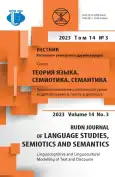The Stylistics of English Headlines in Promotional Discourse: a Multidimensional Study
- Авторлар: Filyasova Y.A.1
-
Мекемелер:
- Saint-Petersburg State University of Economics
- Шығарылым: Том 14, № 3 (2023): LINGUOCOGNITIVE AND LINGUOCULTURAL MODELLING OF TEXT AND DISCOURSE
- Беттер: 856-875
- Бөлім: SEMANTICS AND SEMIOTICS
- URL: https://journal-vniispk.ru/2313-2299/article/view/323422
- DOI: https://doi.org/10.22363/2313-2299-2023-14-3-856-875
- EDN: https://elibrary.ru/FNBDYU
- ID: 323422
Дәйексөз келтіру
Толық мәтін
Аннотация
The study is relevant due to the needs of studying promotional discourse in terms of effective use of linguistic means for product and service promotion in a competitive market. The aim of this study is to study the stylistic and communicative features of headlines in promotional discourse in the English language. The research material included 2092 headlines from 115 automobile brochures (44 car brands). The research methods include discourse analysis, linguocognitive categorization by semantic and functional criteria, quantitative analysis, and cognitive mapping. As a result of the study, it was found that the headlines contained a wide range of stylistic devices. The most numerous are lexical means - hyperbole, metaphor, epithet, personification, idioms, metonymy, repetition, incorporation, and blends. The figures of speech based on syntactic means - hyperbole, comparison, antithesis, parceling, parallelism, emphasis, inversion, framing, anaphora, chiasm, and pun - occurred less frequently. However, considering the syntactic organization of the headlines with the predicative, imperative, gerundial, attributive and interrogative structures, syntactic means were found dominant due to their wider functionality. Among phonetic devices, alliteration prevailed. The communicative techniques included customization, text navigation, storytelling, informative facts and issues related to driving. The majority of the headlines epitomized a synthesis of various stylistic means whose classification was fulfilled only for the purposes of the linguistic research. The headline length varied within 1-23 words (average 5, median 4, STD 2.75); standard being concise, while creative - more extended. Thematically, the headlines accentuated comfort, emotional commitment to the brands, engine capacity and their low footprint. The obtained results could be used in the practice of teaching English for specific purposes to students specializing in marketing, advertising and public relations.
Авторлар туралы
Yulia Filyasova
Saint-Petersburg State University of Economics
Хат алмасуға жауапты Автор.
Email: phill.yield@gmail.com
ORCID iD: 0000-0002-9728-9458
SPIN-код: 9503-8000
PhD in Philology, Associate Professor of the English Philology and Translation Department, Humanitarian Faculty
30-32 Griboyedov Canal Embankment, Saint-Petersburg, Russian Federation, 191023Әдебиет тізімі
- Sakaeva, L.R., Yahin, M.A., Kuznetsova, E.V. & Ibragimova, V.L. (2019). Functional languages in the context of globalization: The language of advertising. Journal of Research in Applied Linguistics, 10, 725-731. https://doi.org/10.22055/rals.2019.15125
- Arrese, A. (2021). The use of ‘bubble’ as an economic metaphor in the news: The case of the ‘real estate bubble’ in Spain. Language & Communication, 78, P100-108. https://doi.org/10.1016/j.langcom.2021.03.001
- Al-Subhi, A.S. (2022). Metadiscourse in online advertising: Exploring linguistic and visual metadiscourse in social media advertisements. Journal of Pragmatics, 187, 24-40. https://doi. org/10.1016/j.pragma.2021.10.027.
- Polyakova, G.M. (2015). Linguocultural Analysis of the Advertisement Language in the American English. RUDN Journal of Language Studies, Semiotics and Semantics, 2, 125-131. (In Russ.).
- Burgers, Ch., de Lavalette, K.Y.R. & Steen, G.J. (2018). Metaphor, hyperbole, and irony: Uses in isolation and in combination in written discourse. Journal of Pragmatics, 127, 71-83. https://doi.org/10.1016/j.pragma.2018.01.009
- Carnevale, M., Luna, D. & Lerman, D. (2017). Brand linguistics: A theory-driven framework for the study of language in branding. International Journal of Research in Marketing, 34(2), 572-591. https://doi.org/10.1016/j.ijresmar.2017.01.003
- Feng, W., Wu, D.D. & Yi, L. (2021). Transcultural brand communication: Disneyland’s social media posts from USA to Hong Kong and Shanghai. Discourse & Communication, 15(6), 690-706. https://doi.org/10.1177/17504813211026508
- Novospasskaya, N.V. & Zou, H. (2021). The Formation of Polycode Text Theory. RUDN Journal of Language Studies, Semiotics and Semantics, 12(2), 501-513. https://doi.org/10.22363/2313-2299-2021-12-2-501-513
- Zotova, A.S. (2021). Semiotics of Advertising Communication in WEB 2.0 Network Social Services. RUDN Journal of Language Studies, Semiotics and Semantics, 12(4), 1285-1298. https://doi.org/10.22363/2313-2299-2021-12-4-1285-1298 (In Russ.).
- Denisenko, V.N., Krasina, E.A., Lazareva, O.V. (2019). Systemic typology of languages: analysis and synthesis in linguistic studies. RUDN Journal of Language Studies, Semiotics and Semantics, 10(1), 9-18. https://doi.org/10.22363/2313-2299-2019-10-1-9-18
- Filyasova, Y.A. (2020). A Linguistic Analysis of Petroleum-Related English Research Article Titles. RUDN Journal of Language Studies, Semiotics and Semantics, 11(1), 120-134. https://doi.org/10.22363/2313-2299-2020-11-1-120-134
- Filyasova, Y.A. (2018). News Headlines: A Contrastive Linguistic Analysis. In: 5th International Multidisciplinary Scientific Conference on Social Sciences and Arts SGEM 2018, Vienna, 19-21 March, 5 (3.1). Vienna. pp. 333-344. https://doi.org/10.5593/sgemsocial2018H/31/S10.042
Қосымша файлдар









